 ... ...
We all have heard that if you say the glass is half-full, you're an optimist, but if you say it's half-empty, you're a pessimist. Perhaps, I may have to settle for being branded a "pessimist" because Shadowgate 64 is a game that left me feeling half-empty.
For years I've been a fan of the classic NES version of Shadowgate, a "point-and-click" adventure game brought over from the PC world. You played the role of a young knight whose quest was to find and defeat the Warlock Lord inside Castle Shadowgate's mysterious, and often dangerous halls. Each room of the eerie chateau was a still picture, often teeming with objects that you could examine, take, and/or use. By using the right items in the right situations, you would slowly begin to solve the game's myriad puzzles. Shadowgate was a game that held me completely enrapt during the month or so it took me to complete it.
Shadowgate 64 is the first installment the series has seen since Beyond Shadowgate on the Turbo Duo. However, instead of having still pictures for rooms, the game is now completely 3D. You move about freely as in first-person games like DOOM and Turok (but without the shooting). The story takes place several years after the original Shadowgate (hereafter referred to as SG1). The Warlock Lord was defeated years ago, but both Lord Jair (the previously unnamed hero of SG1) and his mentor Lakmir the Wizard have passed on, and Castle Shadowgate has degraded from its former splendor into a home for roving bandits. Rumors of the Warlock Lord's resurrection are running rampant, and only one who can pass the Trials of Shadowgate's Four Towers can hope to thwart him. You, of course, are that one.
Even though they were just inanimate illustrations, the graphics of SG1 had a very mysterious and wondrous quality to them. Now that I'm older I'm able to see just how poorly-drawn some things were, but there is still very little I would've traded the look of that game for...least of all, not SG64's approach.
The extra attention to details in some areas definitely imply that the creators of this game cared about it, and some things truly sparked my imagination. For example, when you arrive in the first tower of the castle, watch the chandelier carefully. You'll notice a cat leap out and run up the stairs. Walk up the stairs and you'll find him resting on a window ledge in the library. The polygonal rocking horse in the nursery (that actually rocks when you investigate it) looks amazingly lifelike. The cathedral is one of the more graphically impressive areas, with beautiful marble statues outside and brightly-colored stained-glass windows. When you walk inside, look carefully and you'll notice some old tiles falling from the church's ceiling. But my favorite, and the most marvelous, effect in the game is a room that has an entire galaxy painted on the ceiling! What happens when you solve this particular room's puzzle is a sight to behold.
But for every eerie graveyard, dank cavern, and whimsical effect that SG64 had, there was this equally mundane feeling that permeates the entire castle from its foundation to its lofty turrets. SG1 had rooms of every shape and sort imaginable: Rooms of water, fire, roughly-hewn caverns, mirrors, coffins and more. Castle Shadowgate had rooms that defied the laws of the space-time continuum! And each had its own distinct aura or mystery. SG64, on the other hand, is composed of mind-numbingly normal rooms, many of which are so similar to each other, that I often wondered if I was coming or going. (Didn't I just pass this room of tables and books before?) One of the nitpicks in my review of Uninvited was that exploring a relatively "everyday" mansion wasn't as exciting as exploring Castle Shadowgate's imaginative interiors. But even Uninvited had more interesting things to see than SG64.
The use of color is another issue in Shadowgate 64; if only it had been as elegant as the architecture is in some areas. Mostly only very dull greys, browns, and other muddy colors are used. This must have been a stylistic choice, because it's not as though bright colors aren't possible (the stained-glass windows and occasional purple flame prove that.) Maybe this game could've benefitted from use of the N64 expansion pack, but it wouldn't have hurt if things had just been a little more colorful.
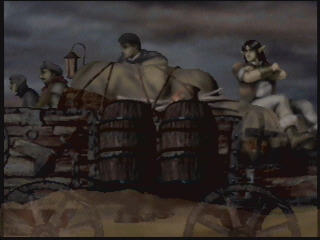 ... ...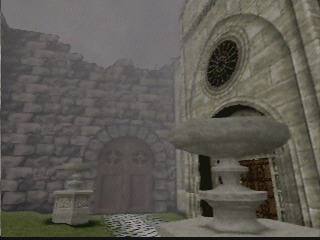
Shadowgate 64's music has a "celtic" flavor and some of the melodies are pleasing, but it's not the type of stuff that makes me wonder about my surroundings. These tunes might be appropriate in relaxed RPG settings (such as towns or shops), but as something that should draw me into the world and make me ponder if there are deeper mysteries at hand, they fail miserably. Even now I find it difficult to recall much of the music.
The sound effects are equally bland. In SG1, when a puzzle was solved, sometimes there'd be this "whooping" sound effect that would "congratulate" you on making the correct move. The screen would light up and flash, there'd be a short animation, and you were genuinely rewarded for your efforts. SG64 has nothing like that, and it made me realize just how important little touches like that can be. Perhaps the praise you get from Lakmir's spirit now and then was meant to replace this. Personally, I still prefer the goofy sound effects and fanfare to some old wizard telling me I'm walking the right path every few rooms or so.
I am a firm believer that gameplay is always more important than story, but I think that atmosphere is much of what Shadowgate is all about. Because there is no action in these types of games, it's important for there to be something else to hold your interest. SG1 was basically a version of those old PC text adventures where you'd have a line saying something like, "You are standing in a room. You see a sword, a shield, and a dragon. What do you do?", only with graphics instead of just lines of text. I remember finding those games a lot of fun back in the day, and Shadowgate's bright pictures brought that genre to life.
SG64's atmosphere does have an ambient quality, but the surroundings are just far too mundane to evoke the sense of being in a mysterious place where danger lurks at every turn. When compared to other 3D "gothic"-environment games, nothing in SG64 comes close to the psychological horror of Shadow Man's worlds or Shamsuk's Tower of Aidyn Chronicles.
The most glaring reason for this lack of atmosphere comes from the single biggest problem I have with SG64: There are practically NO monsters in this game at all! (Well, there is one, whose presence is hinted at early in the game, but that's hardly enough, and it doesn't help that it's the most generic of monsters, either.) The monsters were undoubtedly the coolest thing about SG1. You never knew what twisted horror of magic or science may lurk in the next room, or when a fiery hellhound would just materialize in front of your eyes. But in SG64, gone are the monsters and in their place is a bunch of extremely talkative thieves. Hooray!
Apparently, all the monsters that once inhabited Castle Shadowgate are gone, and the castle has now become a home for bandits, thieves, and other ruffians. I almost have to wonder if this was done because of new-age mentality that an RPG has to have a "great story" to be good, and many believe lots of talking = "great story". But not only do these thieves have hardly anything interesting to say, they're also cursed with these annoying gestures that they must fully play out each time you talk to them.
The best parts of SG64's story come from gleaning anecdotes and information from the various books you find. The game's dialogue is written with the same tongue-and-cheek, dry sense of humor that SG1 had. Picking up objects may cause the game to quip, "You decide to take the pen, knowing that it is mightier than any sword," or "You take the diary, though you feel a little guilty about it," or "You take the cup. You've decided that you've always wanted a cup like this." No, it doesn't sound that funny when I try to paraphrase it, but it does seem humorous in the context of the game. And there are references to SG1 galore.
But those references constantly reminded me of how much I preferred the lonely atmosphere of SG1 to SG64's boring thief town. What you weren't told you had to figure out on your own, and such an approach was much more effective. There are also a couple of plot threads in SG64 that either go nowhere (like one involving a woman who allegedly "saved" you) or are not fully explained (I still don't completely understand the ordeal with the dragon.)
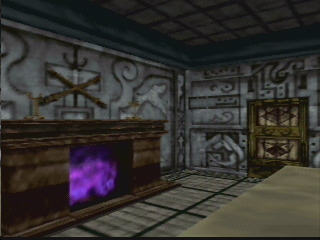 ... ...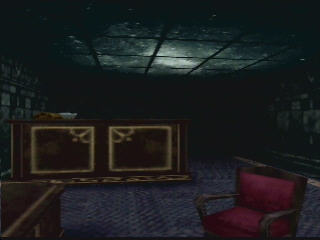
Shadowgate, of course, is not a game that gives you an action challenge (unless you count a few parts where you have to "watch your step" as you walk.) You find and examine objects in a room, then you take them and figure out where to use them or who to give them to. But it's not always as simple or obvious as it sounds. You may find a locked door, then find a key. But that key may not open the door in the usual way. You may have to use the key in a more abstract way to progress. Sometimes, you will need to piece together clues from what you read in books. Other times, you'll have to answer questions based on "trivia" from earlier in the game.
Some of the puzzle solutions I found to be much too obvious. Others were only a matter of trial and error. The "trial and error" tasks were fun to complete, but they weren't anything that I hadn't seen in RPG and adventure games before. SG64 actually has a warp maze: A labyrinth of Knight Statues that act as warps. Touching the wrong one sends you back to the beginning of the maze, not unlike the Castle of Ordeals in Final Fantasy 1 (NES). Another "trial and error" task is a music-note matching puzzle, which is also fun to do, but nothing new.
If I didn't compare Shadowgate 64 to the original Shadowgate so much, would I have felt differently? Probably, yes, but I would've felt even more loathesome of it. Why? Because much of the fun of SG64 is seeing all the references to SG1 here and there. As a game that is supposed to "be like" SG1, it's not all that bad. But as a game all on its own, it feels very inadequate. I have played many RPGs and adventure games that have borrowed from the Shadowgate concept, but they usually combine the puzzle-solving with fighting and other tasks for a fuller experience. Perhaps one good thing about SG64's approach is that you don't have to worry about healing or level-building, but it still feels like only half a game.
Although there are four towers to conquer, I spent more time in the first tower than all the others combined. It seemed like the puzzle solutions kept getting easier and easier the farther I got, until the game just completely ran out of air! But I don't want to be entirely negative. Some of what is there is rather good. I was enamored with this one particular sequence that, in some ways, pays homage to the original Shadowgate. You must complete a series of puzzles within a time limit (before a candle blows out), which includes a maze of doors and switches, a hall of spinning blades, and a room of mirrors. But there was simply not enough of this kind of thing!
The game feels somewhat incomplete. While SG1 had a lot of unused objects, SG64 has about twice as many useless things, and these are things that seemed like they could have had some use. There is also much wasted space; many rooms that have no purpose and seem like they should, such as the armory and the blacksmith's room. Was there more planned for this game than what went into the final version? Notice the potion bottle in the dungeon that you have no way of reaching.
When I say of Shadowgate 64, "the magic is gone", I mean it literally. There are no spells to learn, none of those goofy, but oh-so-clever "poems" that gave SG1 much of its character. As if things could not get worse, the most disappointing moment of the entire game is the final conflict. It is resolved in such a ridiculous way that it makes the entire "build-up" of your character as Lakmir's "chosen one" seem irrelevant. It comes nowhere close to touching the thrill of SG1's tremendous climax.
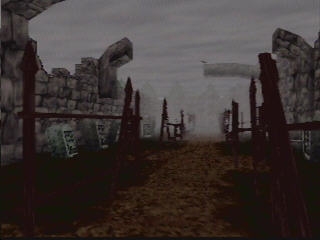 ... ...
I'm worried that this review may give the wrong impression. It's not that I wanted Shadowgate 64 to be "just like" Shadowgate for the NES. But I did expect it to have at least the same level of drama, mystery, intrigue, and challenge, and perhaps, with the power of the N64, elevate that level to a new height. There was the occasional moment when I'd say "cool!" upon witnessing a puzzle's solution go into effect. There was that one particularly good sequence of tests that required more than just the ability to pick an item from your inventory and use it somewhere. But every good puzzle and good sequence of Shadowgate 64 was equalled by the pervavise dullness and general lack of excitement and wonder. For everything SG64 was, there was just so much more it could've been. That glass was half-empty, and it's left me feeling dry.
OVERALL SCORE: 2.5/5
BACK
TO NINTENDO 64 REVIEWS
BACK TO
MAIN
PAGE
| |



